How to grow onions in water on a windowsill?
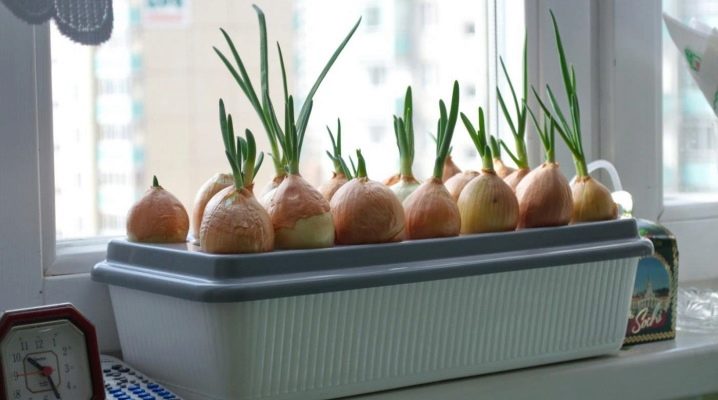
Onions are one of the most popular vegetable crops that many gardeners grow in their summer cottages. However, not everyone owns a summer cottage or plot where such plants can be planted. In this case, it is possible to resort to growing onions at home on the windowsill. In this article, we will find out how this can be done in water.
Advantages and disadvantages
Many people are engaged in growing onions in water, who prefer to care for home plantings displayed on balconies and window sills. The main feature of such agricultural technology is that there is no need to use a suitable soil mixture. At the same time, onions are able to receive all the nutritional components necessary for it exclusively from liquid. By planting the bulbs at intervals of 2-3 weeks, you can easily drive the feathers out on the windowsill throughout the winter season. The main thing is to provide the plants with all the necessary conditions.
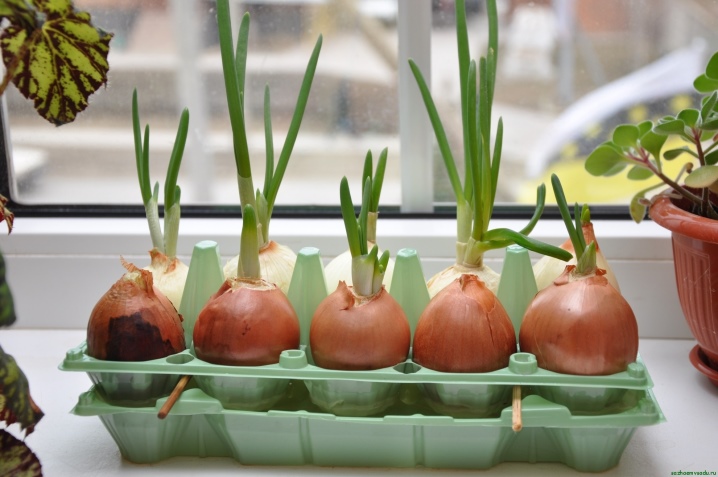
Many people are wondering what are the main advantages of growing onions in water rather than in soil? Let's figure out the answers to this common question.
- One of the main advantages of growing onions in water on a windowsill is the absence of the unpleasant odor of dampness.
- Due to this method of agricultural technology, a person can significantly save money on the purchase of suitable containers and tanks, as well as soil mixtures.
- To place such landings on the window, you do not need too much free space.
- If you properly grow onions in water at home, then people will have the opportunity to get a fresh and healthy product throughout the year.
- The very method of planting onions in water is very simple, it does not take much time. A person does not have to be an experienced agronomist in order to independently carry out all the necessary procedures.
- If a person noticed that there are damaged and diseased bulbs in the container, he can very easily remove and replace them from there.
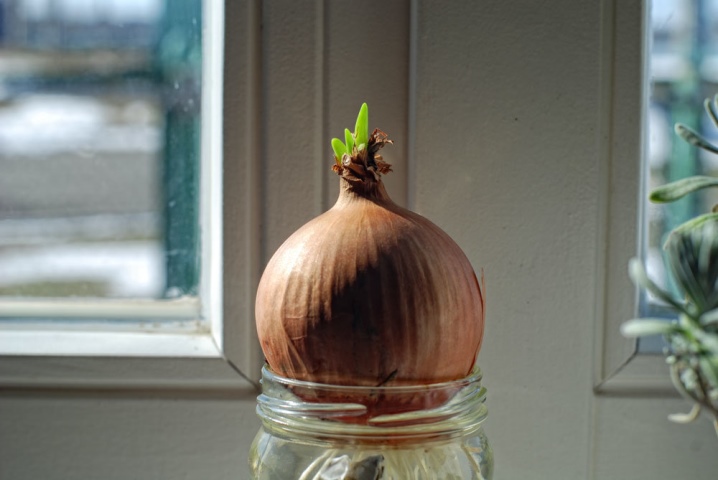
Growing onions in the water at home is not difficult. Such agricultural technology has no serious drawbacks. However, it is imperative to provide competent care for the plant, otherwise the desired effect will not be achieved.
It is also important to ensure that the plants do not start to rot, creating very unpleasant odors in the house.
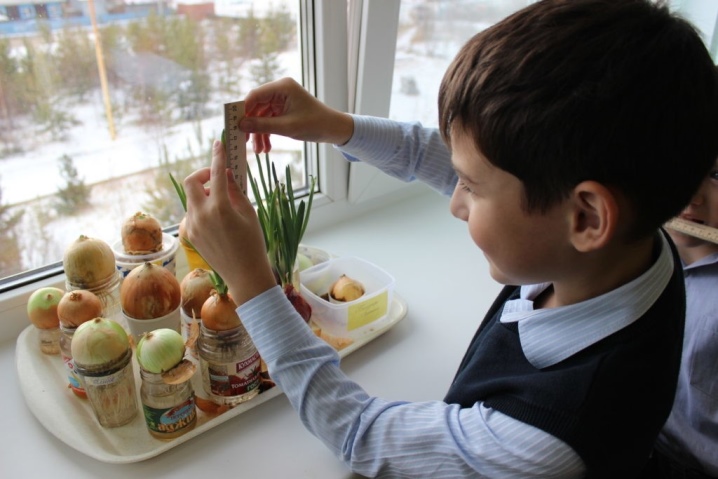
Necessary conditions for growing
The process of planting onions in water is extremely simple and straightforward. In order to get good results in the end, you need to adhere to certain rules. Plants must be provided with all the necessary conditions in which they will be as comfortable as possible.
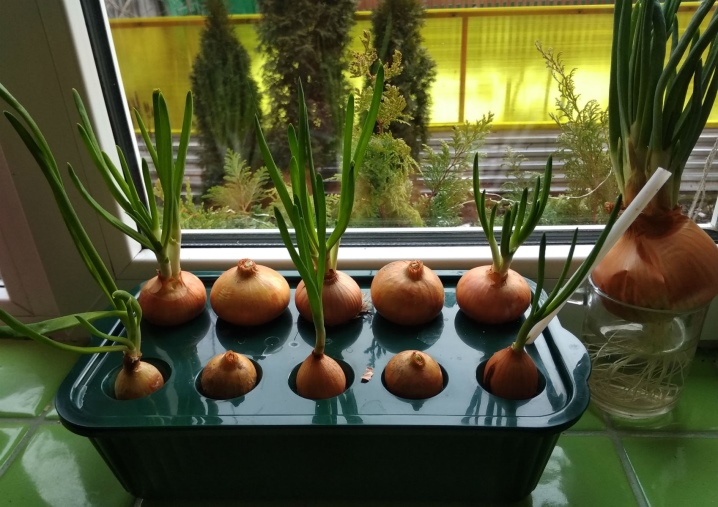
Let's figure out the main points regarding the care of onions planted in water.
- First of all, a bow located at home on a window will need an optimal amount of light. The culture in question loves to "sunbathe" for 24 hours. You can use not only daylight, but also additional lamps at night.
- It is very important to choose the best place to place the plants. A warm windowsill is ideal. Here, the culture will receive not only a sufficient amount of light, but will also be in a temperature environment that is comfortable for it.
- If the plants develop in water, then, of course, they do not need to be additionally watered.However, a person needs to ensure that the roots of the plants reach the liquid in the selected reservoir.
- It is very important to monitor the temperature values in which the culture will grow. At the initial stage of planting, before the first roots appear, the optimum temperature will be from +13 to +15 degrees. It is desirable that the temperature values do not exceed +18 degrees.
- As soon as the first green onion has broken through in the water, the ambient temperature may be slightly higher - from +18 to +20 degrees.
- Onion feathers develop best when the optimum air humidity reaches 70-80%.
If all these conditions are maintained, onions planted in water will grow healthy and of high quality. None of these points can be neglected.

Preparation
You should not rush to plant a vegetable in water for growth on the windowsill. First you need to do the preparatory procedures. It will be necessary to properly prepare for the procedures not only the tank (jar or glass), but also the planting material itself.
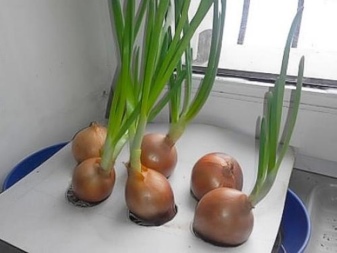

Capacity
For planting the crop in question in water and on a window, almost any type of reservoir can be used. The main thing is that this part has a neck of sufficient width. This requirement plays an important role, since the convenience of placing the bulb in the container depends on it.
Some people prefer to use glasses or jars for planting, but this is not the best solution.
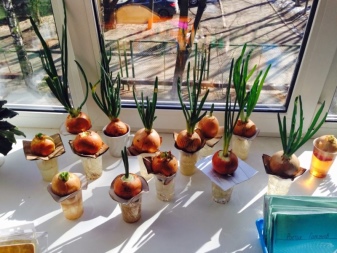
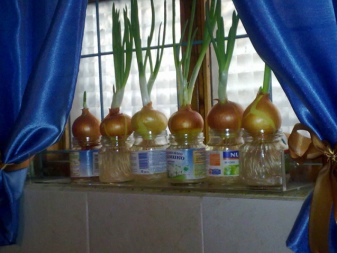
Of course, it is quite possible to grow onions in a glass beaker, but there are more practical options, especially if you plan to grow more than one onion. It is best to use stable plastic containers. Several bulbs can be grown in them at the same time.
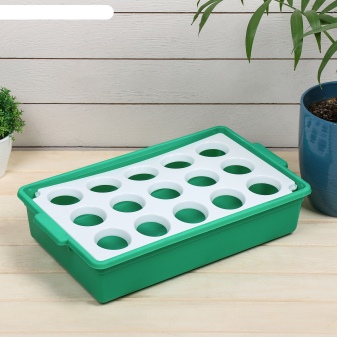
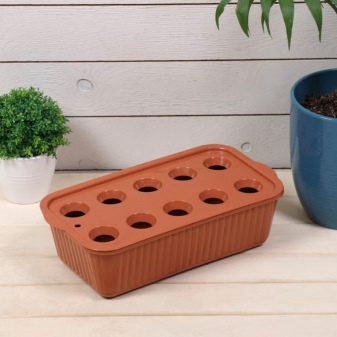
It is desirable that the depth of the reservoir does not exceed 2.5-3 diameters of the bulbs. Before proceeding with direct planting, the container must be thoroughly rinsed with running water. In this case, it is advisable to use laundry soap. Based on the specific material, you can pour boiling water over the tank, a solution of potassium manganese or baking soda.
When using plastic containers, it is worth preparing lids for them in advance. Instead, it is allowed to use thick cardboard sheets with cut holes. The diameter of the latter should correspond to the size of the vegetables.
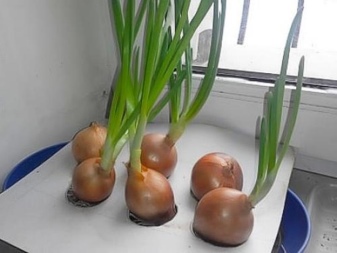
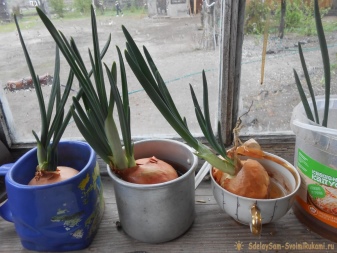
Planting material
For onion sprouting in water to be successful, it is important to prepare the planting material. You can resort to planting almost any variety. Very popular are "Rostovsky", "Pozharsky", "Danilovsky" and others. The buyer can pick up almost any set at his discretion.
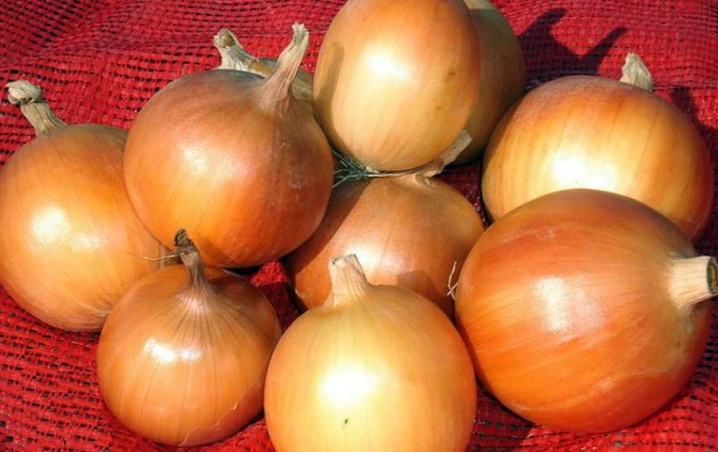
On the window, you can also quickly sprout the onions that were bought in the store. Such a unit must meet one main condition - it must be multi-primordial. This can be easily identified by looking at the cross section. If 3-4 nests already prepared for germination are noticeable on it, then it will bring excellent results for forcing.
For planting, one-size bulbs must be selected, the diameter of which is from 3 to 4 cm. Immediately before the main procedures, the upper layer of the husk is peeled off from the vegetables, all the tops are cut off. The larger the turnip, the larger the cut should be.
Then the bulbs are placed in a heated solution (35-40 degrees is enough) of potassium manganese for about half an hour. Finally, the planting material is rinsed with cold water.
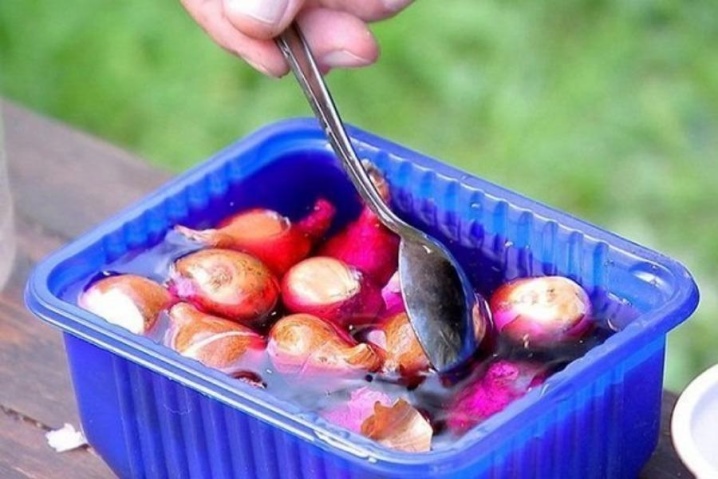
How to "plant" correctly?
We will learn how to plant onions in water correctly step by step without using soil.
- Pre-prepared onions must be carefully planted in a container filled with pre-settled water. The latter should be at room temperature. Planting should take place so that the bulbs are immersed in the liquid by no more than 1/3.
- Until the first green feathers form, the containers must be placed in a cool place, where it is possible to maintain temperature values within 17-20 degrees.
- In the autumn and spring seasons, not only a window sill is suitable, but also a balcony space or a veranda.
- In winter, a window sill located on the north side of the house is best suited for the location of plantings. In this case, heating devices and radiators should be located away from these places. It is recommended to change the water at this time a couple of times a day.
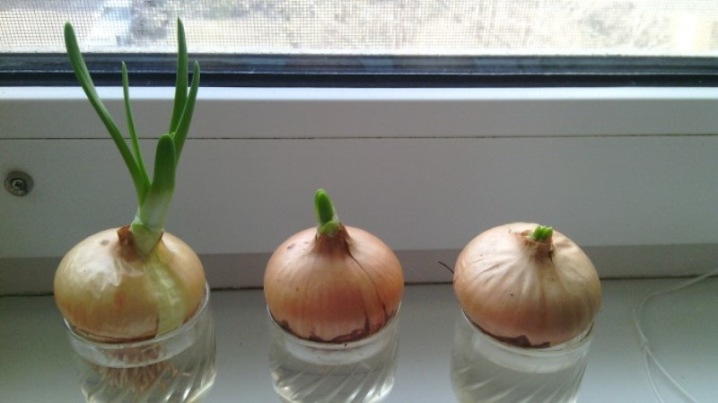
As you can see, the process of planting onions in water is very simple and quick. Any person can easily cope with such manipulations.
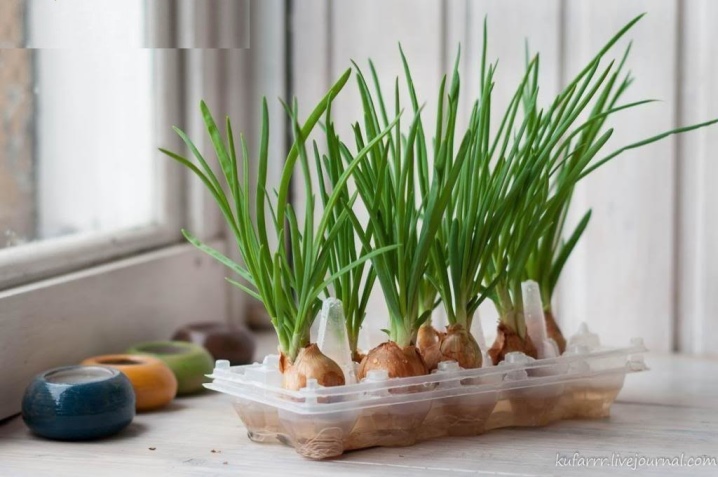
Care
In order to grow high-quality and healthy onions in water on a windowsill, it must be properly and regularly maintained. Consider which care procedures are the most important during the growth of the culture.
- It is important to provide good lighting for the plants. It is best to grow onions on windows facing south or east. As mentioned above, a northerly location is also allowed, but only at certain times.
- If there is not enough light, it will be very bad for vegetables in the water. Because of this, elongated and thinned feathers of a pale green hue can form. In winter, planting can be supplemented with phytolamps.
- Prolonged exposure to direct sunlight will not do much to water planting. Because of this, the tips of the feathers can begin to dry, the greens will soon wither.
- It is necessary to change the water in the containers. For replacement, a settled liquid at room temperature is suitable.
- As the roots grow, the volume of water in the tanks should be gradually reduced. As soon as the roots reach the bottom of the containers, you can spread the fabric of the porous structure on their bottom. In the future, it is enough to wet only this fabric. Due to this, the roots will not rot.
- Plantings must be regularly inspected at all stages of their growth and development. Turnips that have begun to deteriorate should be replaced as soon as possible with new and healthy ones. If the bulb suddenly becomes too soft, covered with dark spots on the surface, then this will indicate that it suffers from one or another disease.
- It is recommended for homemade onions to provide periodic ventilation. For these purposes, the culture will need to be very carefully removed from the tank, and then spread out on a flat and dry surface. Vegetables should be allowed to sit and dry for a while. During this time, you can thoroughly rinse the containers, replace the water and once again carefully inspect the bulbs.
- The onions that grow at home and on the windowsill cannot receive the proper amount of nutrients, like onions growing in the beds. Of course, the plant can be fed, complex types of fertilizers can be added. However, the growing season for the crop in question is very modest, so it is better not to experiment with feeding.
- The optimal is the daily tincture of wood ash. It can be made from 1 tsp. fertilizer and 1 glass of water. The resulting mixture is sent to a container where vegetables grow.
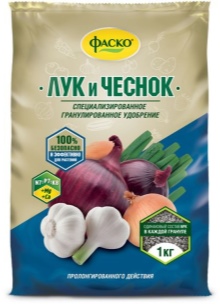
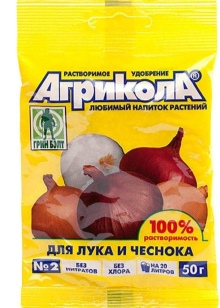
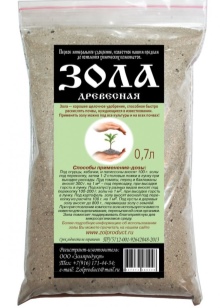
Cutting greens
Onions, which are grown in water and on a windowsill, can be carefully cut off already 15-20 days after the formation of the starting shoots. Overexposing this culture is strongly discouraged, since it will no longer grow anymore. But at the same time, the feathers will begin to fit and get confused with each other, complicating the process of harvesting the resulting crop. And only the onion with a height of 10-15 cm can boast of good taste characteristics.
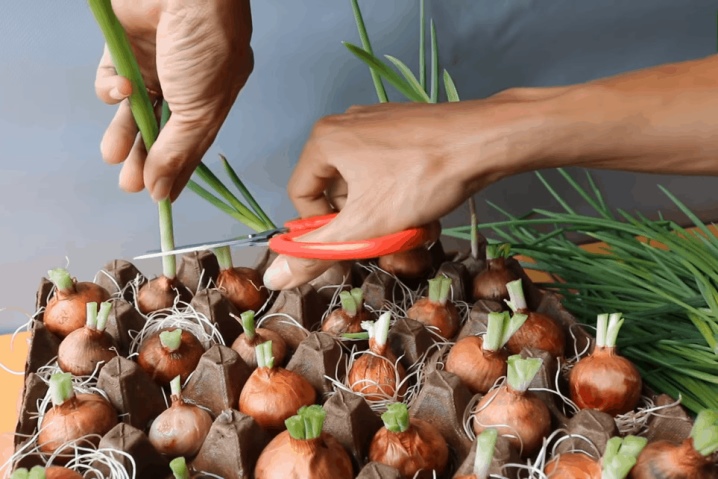
All onion surpluses can be frozen. Previously, these components can be crushed. Frozen onions are unlikely to be suitable for preparing a variety of salads or decorating dishes, but for cooking delicious first and second courses, they will be a very good addition.

Recommendations
Consider some useful tips for growing onions in water at home.
- Only ripe onions are suitable for forcing and growing in water.
- Do not store cut onions in the refrigerator for long. Here it will remain fresh for only a couple of days, after which the feather will fade, lose its juiciness and pleasant taste.
- It is strongly not recommended for green onions growing in water to use metal containers, as well as containers with iron parts in the structure.
- After adding additional fertilizers, it is recommended to postpone the liquid change procedure for several days. Fertilizer must have time to assimilate.
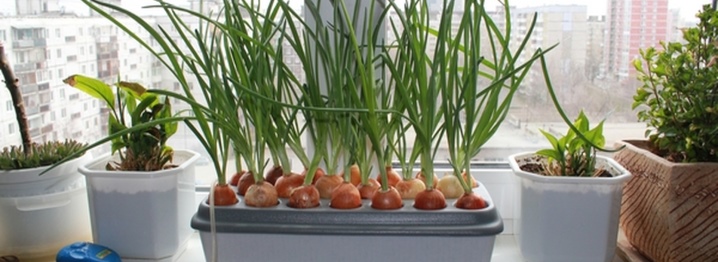













The comment was sent successfully.